Mental Health Social Work in Pennsylvania: Analysis
VerifiedAdded on 2023/06/03
|7
|1898
|444
Report
AI Summary
This report provides an analysis of mental health social work in Pennsylvania, examining legislative efforts, workforce challenges, and the impact on various populations. It references the National Alliance of Mental Illness (NAMI) and a 2015 report addressing mental health reforms following an economic crisis. The report covers topics like state mental health budgets, insurance policies, workforce development, children's mental health, housing, employment, criminal justice, suicide prevention, and crisis care. It highlights the need for integrated healthcare, particularly in primary care settings, and discusses the increasing prevalence of mental illness among college students. Challenges such as a decrease in psychiatric beds and the involvement of individuals with mental illnesses in the criminal justice system are also addressed, along with the implementation of Crisis Intervention Teams (CIT) and mental health courts. The report emphasizes the need for comprehensive and coordinated mental health care systems in Pennsylvania.
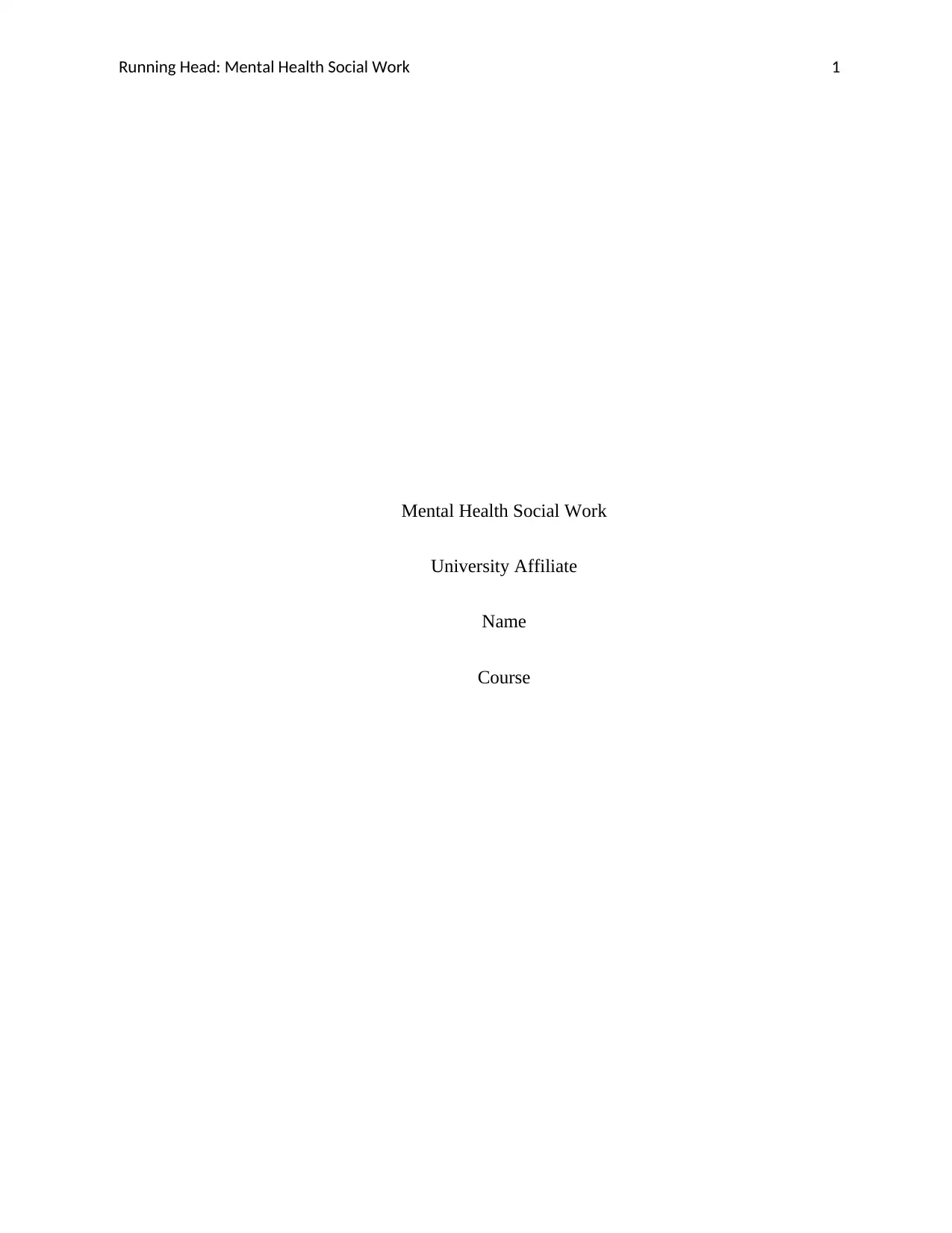
Running Head: Mental Health Social Work 1
Mental Health Social Work
University Affiliate
Name
Course
Mental Health Social Work
University Affiliate
Name
Course
Paraphrase This Document
Need a fresh take? Get an instant paraphrase of this document with our AI Paraphraser
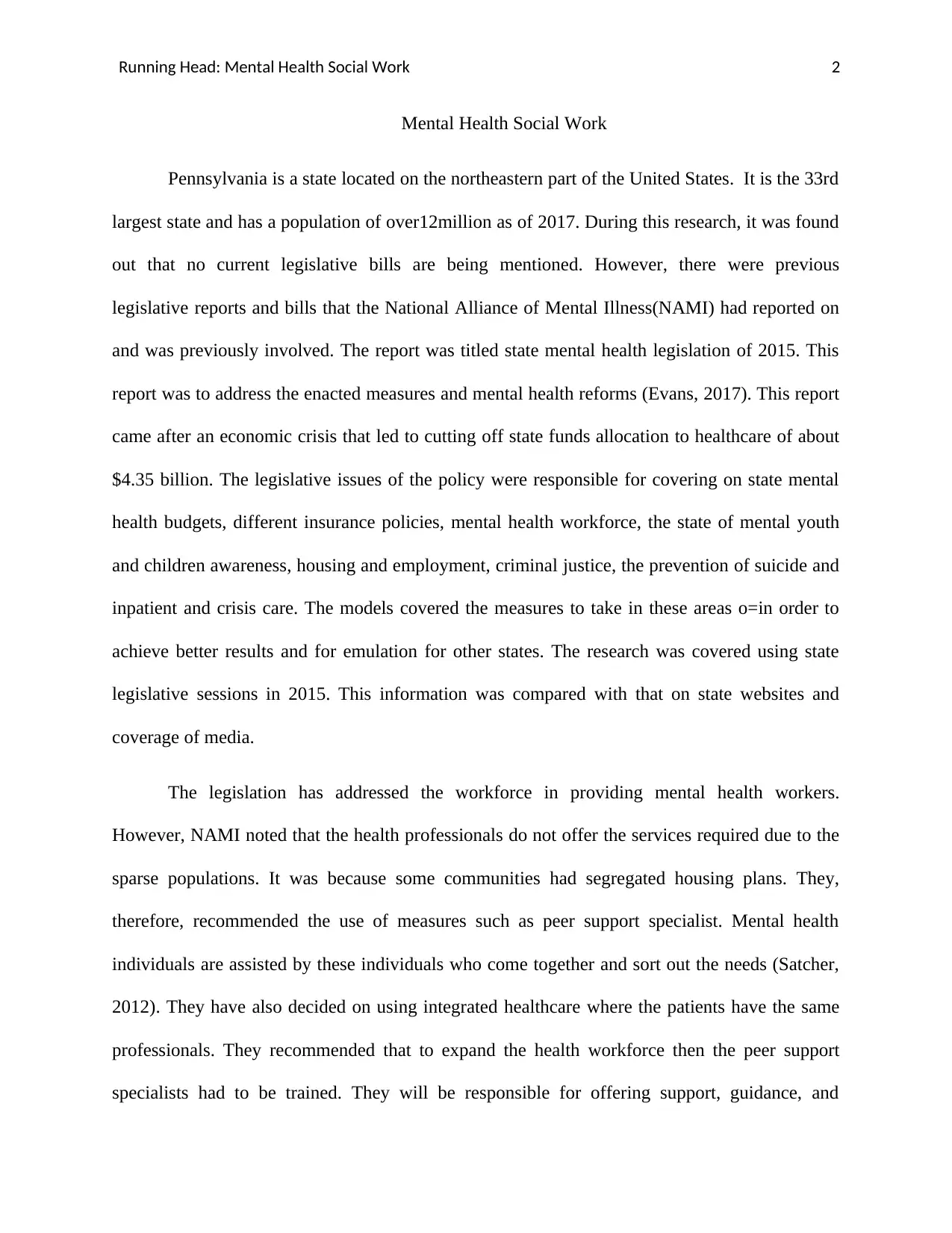
Running Head: Mental Health Social Work 2
Mental Health Social Work
Pennsylvania is a state located on the northeastern part of the United States. It is the 33rd
largest state and has a population of over12million as of 2017. During this research, it was found
out that no current legislative bills are being mentioned. However, there were previous
legislative reports and bills that the National Alliance of Mental Illness(NAMI) had reported on
and was previously involved. The report was titled state mental health legislation of 2015. This
report was to address the enacted measures and mental health reforms (Evans, 2017). This report
came after an economic crisis that led to cutting off state funds allocation to healthcare of about
$4.35 billion. The legislative issues of the policy were responsible for covering on state mental
health budgets, different insurance policies, mental health workforce, the state of mental youth
and children awareness, housing and employment, criminal justice, the prevention of suicide and
inpatient and crisis care. The models covered the measures to take in these areas o=in order to
achieve better results and for emulation for other states. The research was covered using state
legislative sessions in 2015. This information was compared with that on state websites and
coverage of media.
The legislation has addressed the workforce in providing mental health workers.
However, NAMI noted that the health professionals do not offer the services required due to the
sparse populations. It was because some communities had segregated housing plans. They,
therefore, recommended the use of measures such as peer support specialist. Mental health
individuals are assisted by these individuals who come together and sort out the needs (Satcher,
2012). They have also decided on using integrated healthcare where the patients have the same
professionals. They recommended that to expand the health workforce then the peer support
specialists had to be trained. They will be responsible for offering support, guidance, and
Mental Health Social Work
Pennsylvania is a state located on the northeastern part of the United States. It is the 33rd
largest state and has a population of over12million as of 2017. During this research, it was found
out that no current legislative bills are being mentioned. However, there were previous
legislative reports and bills that the National Alliance of Mental Illness(NAMI) had reported on
and was previously involved. The report was titled state mental health legislation of 2015. This
report was to address the enacted measures and mental health reforms (Evans, 2017). This report
came after an economic crisis that led to cutting off state funds allocation to healthcare of about
$4.35 billion. The legislative issues of the policy were responsible for covering on state mental
health budgets, different insurance policies, mental health workforce, the state of mental youth
and children awareness, housing and employment, criminal justice, the prevention of suicide and
inpatient and crisis care. The models covered the measures to take in these areas o=in order to
achieve better results and for emulation for other states. The research was covered using state
legislative sessions in 2015. This information was compared with that on state websites and
coverage of media.
The legislation has addressed the workforce in providing mental health workers.
However, NAMI noted that the health professionals do not offer the services required due to the
sparse populations. It was because some communities had segregated housing plans. They,
therefore, recommended the use of measures such as peer support specialist. Mental health
individuals are assisted by these individuals who come together and sort out the needs (Satcher,
2012). They have also decided on using integrated healthcare where the patients have the same
professionals. They recommended that to expand the health workforce then the peer support
specialists had to be trained. They will be responsible for offering support, guidance, and
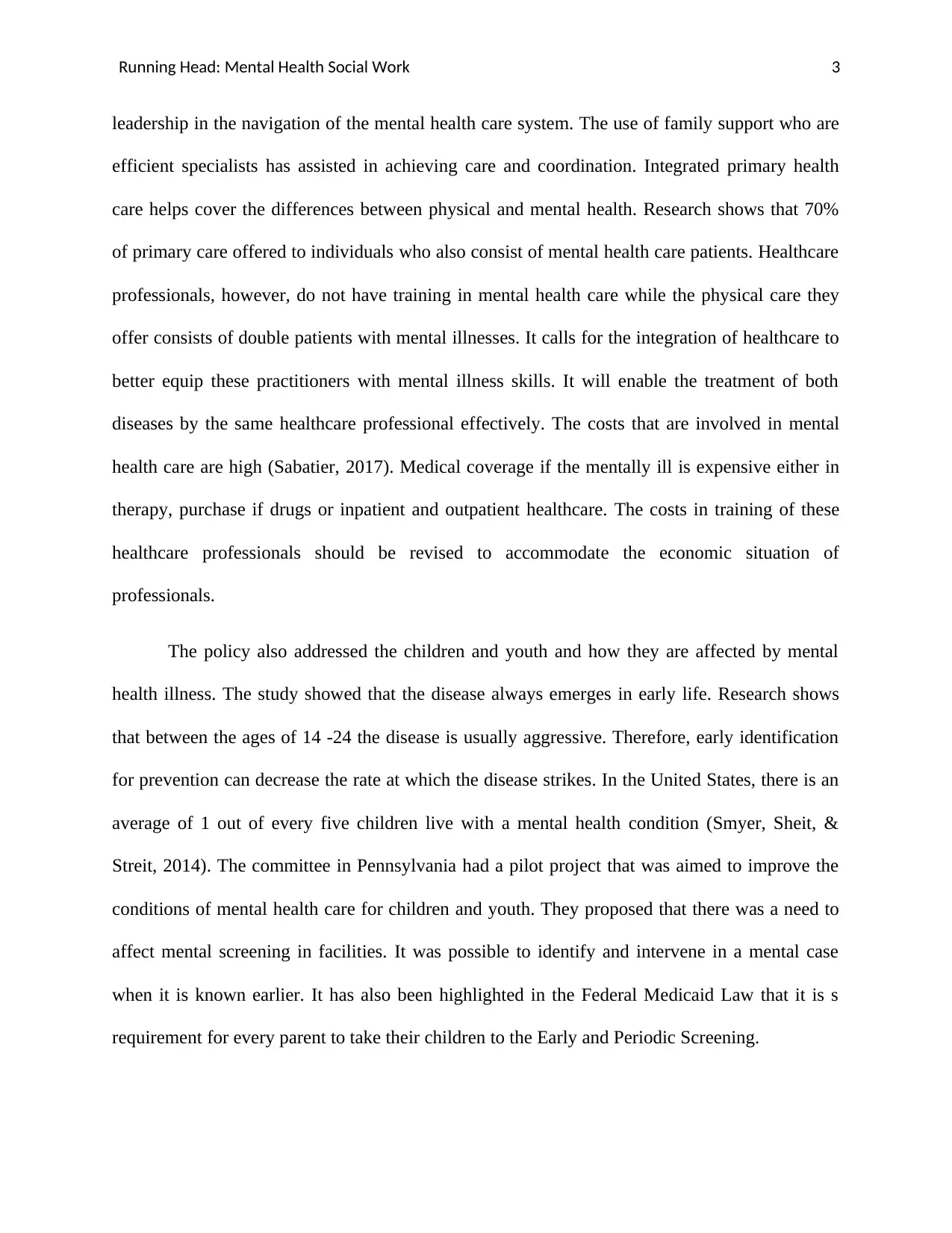
Running Head: Mental Health Social Work 3
leadership in the navigation of the mental health care system. The use of family support who are
efficient specialists has assisted in achieving care and coordination. Integrated primary health
care helps cover the differences between physical and mental health. Research shows that 70%
of primary care offered to individuals who also consist of mental health care patients. Healthcare
professionals, however, do not have training in mental health care while the physical care they
offer consists of double patients with mental illnesses. It calls for the integration of healthcare to
better equip these practitioners with mental illness skills. It will enable the treatment of both
diseases by the same healthcare professional effectively. The costs that are involved in mental
health care are high (Sabatier, 2017). Medical coverage if the mentally ill is expensive either in
therapy, purchase if drugs or inpatient and outpatient healthcare. The costs in training of these
healthcare professionals should be revised to accommodate the economic situation of
professionals.
The policy also addressed the children and youth and how they are affected by mental
health illness. The study showed that the disease always emerges in early life. Research shows
that between the ages of 14 -24 the disease is usually aggressive. Therefore, early identification
for prevention can decrease the rate at which the disease strikes. In the United States, there is an
average of 1 out of every five children live with a mental health condition (Smyer, Sheit, &
Streit, 2014). The committee in Pennsylvania had a pilot project that was aimed to improve the
conditions of mental health care for children and youth. They proposed that there was a need to
affect mental screening in facilities. It was possible to identify and intervene in a mental case
when it is known earlier. It has also been highlighted in the Federal Medicaid Law that it is s
requirement for every parent to take their children to the Early and Periodic Screening.
leadership in the navigation of the mental health care system. The use of family support who are
efficient specialists has assisted in achieving care and coordination. Integrated primary health
care helps cover the differences between physical and mental health. Research shows that 70%
of primary care offered to individuals who also consist of mental health care patients. Healthcare
professionals, however, do not have training in mental health care while the physical care they
offer consists of double patients with mental illnesses. It calls for the integration of healthcare to
better equip these practitioners with mental illness skills. It will enable the treatment of both
diseases by the same healthcare professional effectively. The costs that are involved in mental
health care are high (Sabatier, 2017). Medical coverage if the mentally ill is expensive either in
therapy, purchase if drugs or inpatient and outpatient healthcare. The costs in training of these
healthcare professionals should be revised to accommodate the economic situation of
professionals.
The policy also addressed the children and youth and how they are affected by mental
health illness. The study showed that the disease always emerges in early life. Research shows
that between the ages of 14 -24 the disease is usually aggressive. Therefore, early identification
for prevention can decrease the rate at which the disease strikes. In the United States, there is an
average of 1 out of every five children live with a mental health condition (Smyer, Sheit, &
Streit, 2014). The committee in Pennsylvania had a pilot project that was aimed to improve the
conditions of mental health care for children and youth. They proposed that there was a need to
affect mental screening in facilities. It was possible to identify and intervene in a mental case
when it is known earlier. It has also been highlighted in the Federal Medicaid Law that it is s
requirement for every parent to take their children to the Early and Periodic Screening.
⊘ This is a preview!⊘
Do you want full access?
Subscribe today to unlock all pages.

Trusted by 1+ million students worldwide
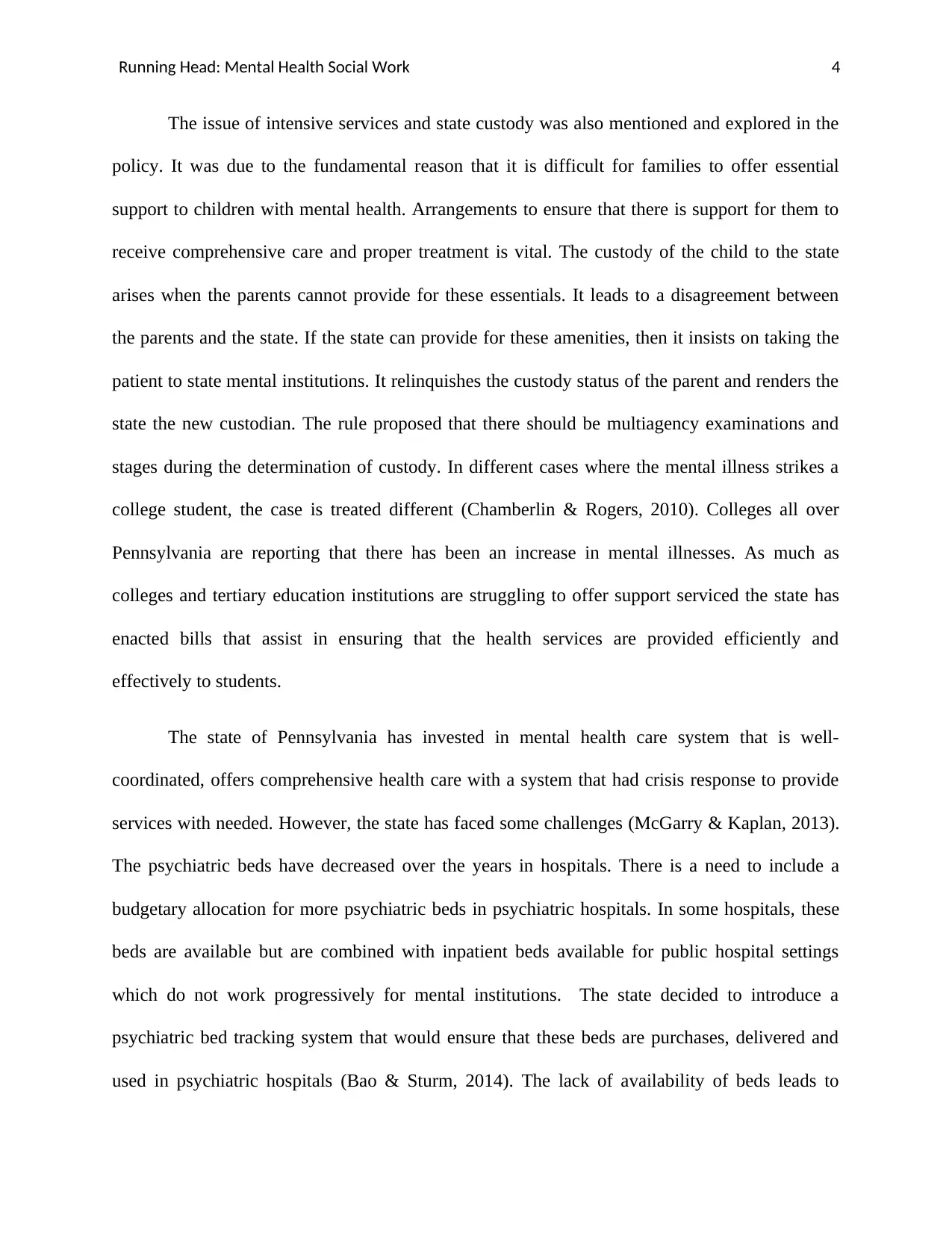
Running Head: Mental Health Social Work 4
The issue of intensive services and state custody was also mentioned and explored in the
policy. It was due to the fundamental reason that it is difficult for families to offer essential
support to children with mental health. Arrangements to ensure that there is support for them to
receive comprehensive care and proper treatment is vital. The custody of the child to the state
arises when the parents cannot provide for these essentials. It leads to a disagreement between
the parents and the state. If the state can provide for these amenities, then it insists on taking the
patient to state mental institutions. It relinquishes the custody status of the parent and renders the
state the new custodian. The rule proposed that there should be multiagency examinations and
stages during the determination of custody. In different cases where the mental illness strikes a
college student, the case is treated different (Chamberlin & Rogers, 2010). Colleges all over
Pennsylvania are reporting that there has been an increase in mental illnesses. As much as
colleges and tertiary education institutions are struggling to offer support serviced the state has
enacted bills that assist in ensuring that the health services are provided efficiently and
effectively to students.
The state of Pennsylvania has invested in mental health care system that is well-
coordinated, offers comprehensive health care with a system that had crisis response to provide
services with needed. However, the state has faced some challenges (McGarry & Kaplan, 2013).
The psychiatric beds have decreased over the years in hospitals. There is a need to include a
budgetary allocation for more psychiatric beds in psychiatric hospitals. In some hospitals, these
beds are available but are combined with inpatient beds available for public hospital settings
which do not work progressively for mental institutions. The state decided to introduce a
psychiatric bed tracking system that would ensure that these beds are purchases, delivered and
used in psychiatric hospitals (Bao & Sturm, 2014). The lack of availability of beds leads to
The issue of intensive services and state custody was also mentioned and explored in the
policy. It was due to the fundamental reason that it is difficult for families to offer essential
support to children with mental health. Arrangements to ensure that there is support for them to
receive comprehensive care and proper treatment is vital. The custody of the child to the state
arises when the parents cannot provide for these essentials. It leads to a disagreement between
the parents and the state. If the state can provide for these amenities, then it insists on taking the
patient to state mental institutions. It relinquishes the custody status of the parent and renders the
state the new custodian. The rule proposed that there should be multiagency examinations and
stages during the determination of custody. In different cases where the mental illness strikes a
college student, the case is treated different (Chamberlin & Rogers, 2010). Colleges all over
Pennsylvania are reporting that there has been an increase in mental illnesses. As much as
colleges and tertiary education institutions are struggling to offer support serviced the state has
enacted bills that assist in ensuring that the health services are provided efficiently and
effectively to students.
The state of Pennsylvania has invested in mental health care system that is well-
coordinated, offers comprehensive health care with a system that had crisis response to provide
services with needed. However, the state has faced some challenges (McGarry & Kaplan, 2013).
The psychiatric beds have decreased over the years in hospitals. There is a need to include a
budgetary allocation for more psychiatric beds in psychiatric hospitals. In some hospitals, these
beds are available but are combined with inpatient beds available for public hospital settings
which do not work progressively for mental institutions. The state decided to introduce a
psychiatric bed tracking system that would ensure that these beds are purchases, delivered and
used in psychiatric hospitals (Bao & Sturm, 2014). The lack of availability of beds leads to
Paraphrase This Document
Need a fresh take? Get an instant paraphrase of this document with our AI Paraphraser
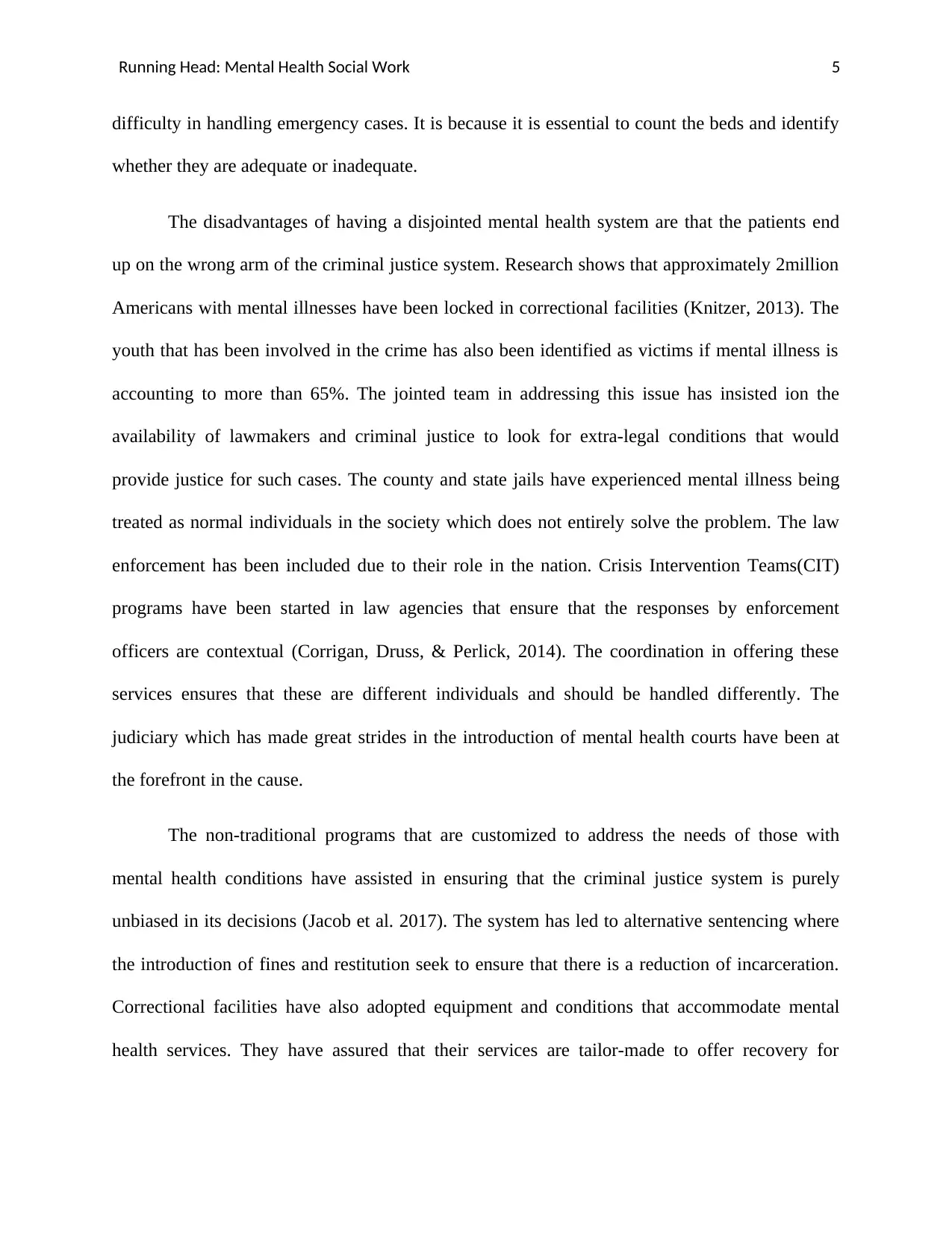
Running Head: Mental Health Social Work 5
difficulty in handling emergency cases. It is because it is essential to count the beds and identify
whether they are adequate or inadequate.
The disadvantages of having a disjointed mental health system are that the patients end
up on the wrong arm of the criminal justice system. Research shows that approximately 2million
Americans with mental illnesses have been locked in correctional facilities (Knitzer, 2013). The
youth that has been involved in the crime has also been identified as victims if mental illness is
accounting to more than 65%. The jointed team in addressing this issue has insisted ion the
availability of lawmakers and criminal justice to look for extra-legal conditions that would
provide justice for such cases. The county and state jails have experienced mental illness being
treated as normal individuals in the society which does not entirely solve the problem. The law
enforcement has been included due to their role in the nation. Crisis Intervention Teams(CIT)
programs have been started in law agencies that ensure that the responses by enforcement
officers are contextual (Corrigan, Druss, & Perlick, 2014). The coordination in offering these
services ensures that these are different individuals and should be handled differently. The
judiciary which has made great strides in the introduction of mental health courts have been at
the forefront in the cause.
The non-traditional programs that are customized to address the needs of those with
mental health conditions have assisted in ensuring that the criminal justice system is purely
unbiased in its decisions (Jacob et al. 2017). The system has led to alternative sentencing where
the introduction of fines and restitution seek to ensure that there is a reduction of incarceration.
Correctional facilities have also adopted equipment and conditions that accommodate mental
health services. They have assured that their services are tailor-made to offer recovery for
difficulty in handling emergency cases. It is because it is essential to count the beds and identify
whether they are adequate or inadequate.
The disadvantages of having a disjointed mental health system are that the patients end
up on the wrong arm of the criminal justice system. Research shows that approximately 2million
Americans with mental illnesses have been locked in correctional facilities (Knitzer, 2013). The
youth that has been involved in the crime has also been identified as victims if mental illness is
accounting to more than 65%. The jointed team in addressing this issue has insisted ion the
availability of lawmakers and criminal justice to look for extra-legal conditions that would
provide justice for such cases. The county and state jails have experienced mental illness being
treated as normal individuals in the society which does not entirely solve the problem. The law
enforcement has been included due to their role in the nation. Crisis Intervention Teams(CIT)
programs have been started in law agencies that ensure that the responses by enforcement
officers are contextual (Corrigan, Druss, & Perlick, 2014). The coordination in offering these
services ensures that these are different individuals and should be handled differently. The
judiciary which has made great strides in the introduction of mental health courts have been at
the forefront in the cause.
The non-traditional programs that are customized to address the needs of those with
mental health conditions have assisted in ensuring that the criminal justice system is purely
unbiased in its decisions (Jacob et al. 2017). The system has led to alternative sentencing where
the introduction of fines and restitution seek to ensure that there is a reduction of incarceration.
Correctional facilities have also adopted equipment and conditions that accommodate mental
health services. They have assured that their services are tailor-made to offer recovery for
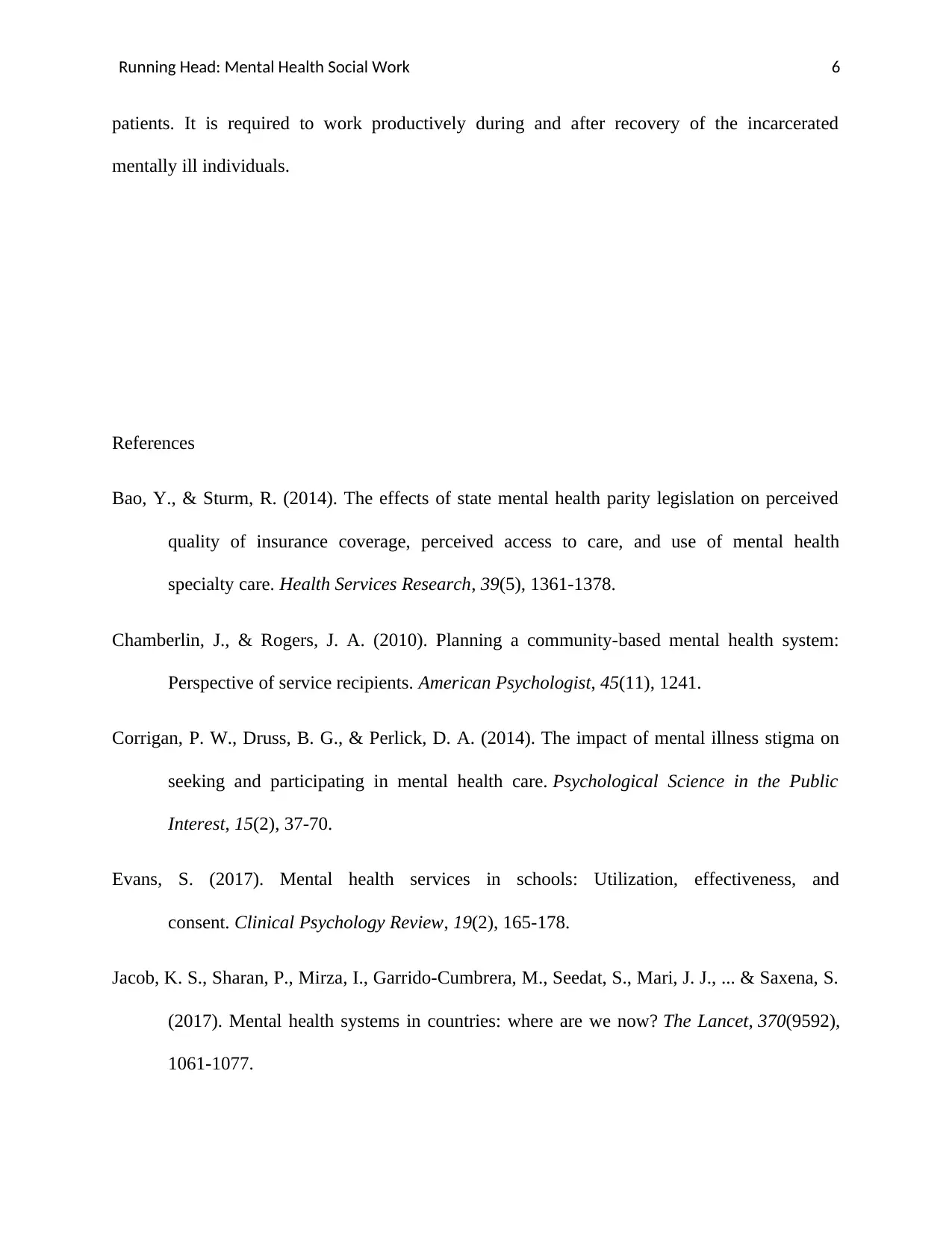
Running Head: Mental Health Social Work 6
patients. It is required to work productively during and after recovery of the incarcerated
mentally ill individuals.
References
Bao, Y., & Sturm, R. (2014). The effects of state mental health parity legislation on perceived
quality of insurance coverage, perceived access to care, and use of mental health
specialty care. Health Services Research, 39(5), 1361-1378.
Chamberlin, J., & Rogers, J. A. (2010). Planning a community-based mental health system:
Perspective of service recipients. American Psychologist, 45(11), 1241.
Corrigan, P. W., Druss, B. G., & Perlick, D. A. (2014). The impact of mental illness stigma on
seeking and participating in mental health care. Psychological Science in the Public
Interest, 15(2), 37-70.
Evans, S. (2017). Mental health services in schools: Utilization, effectiveness, and
consent. Clinical Psychology Review, 19(2), 165-178.
Jacob, K. S., Sharan, P., Mirza, I., Garrido-Cumbrera, M., Seedat, S., Mari, J. J., ... & Saxena, S.
(2017). Mental health systems in countries: where are we now? The Lancet, 370(9592),
1061-1077.
patients. It is required to work productively during and after recovery of the incarcerated
mentally ill individuals.
References
Bao, Y., & Sturm, R. (2014). The effects of state mental health parity legislation on perceived
quality of insurance coverage, perceived access to care, and use of mental health
specialty care. Health Services Research, 39(5), 1361-1378.
Chamberlin, J., & Rogers, J. A. (2010). Planning a community-based mental health system:
Perspective of service recipients. American Psychologist, 45(11), 1241.
Corrigan, P. W., Druss, B. G., & Perlick, D. A. (2014). The impact of mental illness stigma on
seeking and participating in mental health care. Psychological Science in the Public
Interest, 15(2), 37-70.
Evans, S. (2017). Mental health services in schools: Utilization, effectiveness, and
consent. Clinical Psychology Review, 19(2), 165-178.
Jacob, K. S., Sharan, P., Mirza, I., Garrido-Cumbrera, M., Seedat, S., Mari, J. J., ... & Saxena, S.
(2017). Mental health systems in countries: where are we now? The Lancet, 370(9592),
1061-1077.
⊘ This is a preview!⊘
Do you want full access?
Subscribe today to unlock all pages.

Trusted by 1+ million students worldwide
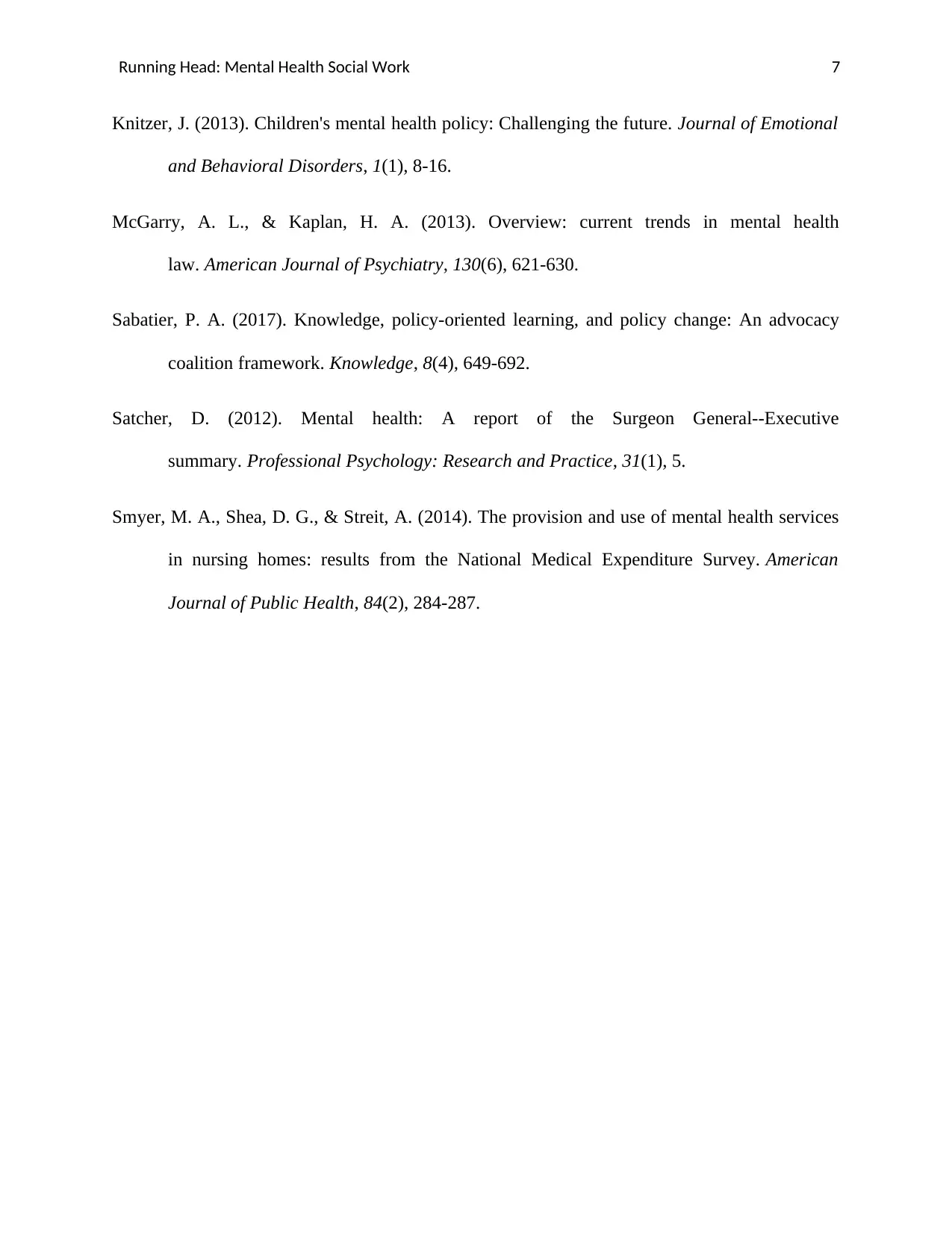
Running Head: Mental Health Social Work 7
Knitzer, J. (2013). Children's mental health policy: Challenging the future. Journal of Emotional
and Behavioral Disorders, 1(1), 8-16.
McGarry, A. L., & Kaplan, H. A. (2013). Overview: current trends in mental health
law. American Journal of Psychiatry, 130(6), 621-630.
Sabatier, P. A. (2017). Knowledge, policy-oriented learning, and policy change: An advocacy
coalition framework. Knowledge, 8(4), 649-692.
Satcher, D. (2012). Mental health: A report of the Surgeon General--Executive
summary. Professional Psychology: Research and Practice, 31(1), 5.
Smyer, M. A., Shea, D. G., & Streit, A. (2014). The provision and use of mental health services
in nursing homes: results from the National Medical Expenditure Survey. American
Journal of Public Health, 84(2), 284-287.
Knitzer, J. (2013). Children's mental health policy: Challenging the future. Journal of Emotional
and Behavioral Disorders, 1(1), 8-16.
McGarry, A. L., & Kaplan, H. A. (2013). Overview: current trends in mental health
law. American Journal of Psychiatry, 130(6), 621-630.
Sabatier, P. A. (2017). Knowledge, policy-oriented learning, and policy change: An advocacy
coalition framework. Knowledge, 8(4), 649-692.
Satcher, D. (2012). Mental health: A report of the Surgeon General--Executive
summary. Professional Psychology: Research and Practice, 31(1), 5.
Smyer, M. A., Shea, D. G., & Streit, A. (2014). The provision and use of mental health services
in nursing homes: results from the National Medical Expenditure Survey. American
Journal of Public Health, 84(2), 284-287.
1 out of 7
Related Documents
Your All-in-One AI-Powered Toolkit for Academic Success.
+13062052269
info@desklib.com
Available 24*7 on WhatsApp / Email
![[object Object]](/_next/static/media/star-bottom.7253800d.svg)
Unlock your academic potential
Copyright © 2020–2025 A2Z Services. All Rights Reserved. Developed and managed by ZUCOL.





